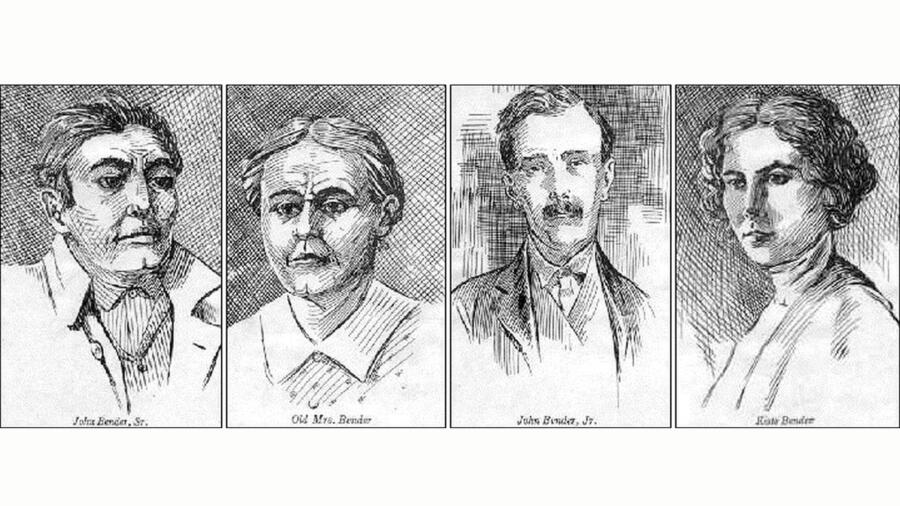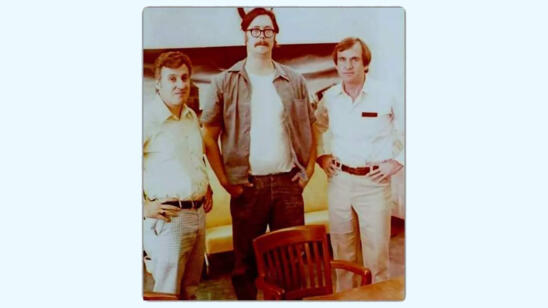A group known as “The Bender family”—comprised of “Ma” Bender, whose real name remains elusive, John, or “Pa,” Bender, Kate Bender and John Gebhardt—once ran a roadside inn in Labette County, Kansas. When questions began to arise regarding the Benders’ connection to missing people, they fled the state. Authorities ultimately accused the Benders of committing 11 murders between 1870 and 1873. The foursome was never caught.
Their story is the focus of Susan Jonusas’s Hell’s Half-Acre: The Untold Story of the Benders, a Serial Killer Family on the American Frontier. Jonusas spoke with A&E True Crime about why she believes the Benders, also known as the “Bloody Benders” in the press, passed themselves off as relatives and what she thinks happened to them.
The Benders told people they were family. Why do you doubt that?
My personal feeling is that Kate and Ma were probably biological mother and daughter, and Kate and John Gebhardt were probably common-law married. People in the community described them as having an intimacy that made them seem more like husband and wife than brother and sister. I think Pa is one of Ma’s many [previous] husbands. It wasn’t uncommon for women to be married a lot at the time, especially if they were working class.
Why would they lie to people about their relationship?
It raises less questions in the community. In the traditional frontier homestead family, it’s the parents, children and grandchildren. With the absence of kids, it raises less questions if this was just an older family unit.
[Stream episodes of Accused: Guilty or Innocent? in the A&E app.]
Where do you think they came from?
Kate was definitely born in America and was raised in a German-speaking family. I think the rest of the group all came from Germany.
What were they like?
The older couple seemed quite withdrawn. They probably lived hard lives and were not that interested in interacting with the community.
Kate is the most compelling of the group…someone who wanted a life that she didn’t have the means to attain or wasn’t willing to work hard enough to attain. Crime, for her, was an easy way to make money.
Gebhardt at first seems very pious, quiet and kind of under Kate’s control. But he turns out to be a glib person, a con artist. He uses his charm to win people over, initially, but isn’t quite bothered to keep up appearances in the long run. You see that with Kate, too.
Why did they open an inn in their modest one-room cabin?
Certainly with the intention to rob people. [Frontier Kansas] was a good place for them to move stolen goods without attracting too much attention, because you could blame [crime] on bandits and Indigenous people. I believe they killed their first victim by accident in a robbery gone wrong. When no one came looking for him, they thought, ‘We can get away with this.’ I think they were naturally violent people, and that made it easy.
After the Benders abandoned their homestead in April 1874, eight victims were found in the orchard on their property and three in a nearby prairie. All were men travelling alone, except for a father and daughter pair. How were they killed?
All had impact wounds to head, temples and base of the neck, and also slit throats.
Why did you conclude the murders were more likely committed by Pa Bender and John Gebhardt?
At the time, the newspapers were very keen to say that Kate did it—or was involved in the physical act. The truth is, we will never know. I did a lot of academic reading. It’s very unusual for a family to do this, and for a woman to consistently kill in this way, with impact violence. We see [that] much more with men. I think Gebhardt was the driving force behind the violence, because we later see him involved with a very violent group of men.
Why were the Benders never caught after they fled Kansas?
Lots of people have lots of different theories of where they ended up.
Samuel Merrick [an outlaw who traveled with them] said to his prison guards that he knew where they were. Bill and Frank McPherson, two brothers who were criminals, [said they] knew where they were.
All the [newspaper] reports said the authorities didn’t know where they were, but that just wasn’t true. From the research I did, they knew where the Benders were for about 18 months. There was lots of correspondence, and it became apparent that the government didn’t have the money to keep after them. At one point, the Kansas authorities wrote to the military in Texas, which wrote back, basically saying, ‘That’s not our problem. We are too busy dealing with the Indian wars.’ There was also lots of local corruption. The Benders were warned when authorities were in town and were coming to get them.
Two women, Almira Monroe and Sarah Davis, were wrongly accused of being Ma and Kate Bender, and went to a preliminary trial, narrowing avoiding a full trial . What happened?
Lots of people who’d never seen the Benders claimed [Monroe and Davis] were the Benders. The community was so split on whether or not they were. They came dangerously close [to going to trial] because [the authorities] didn’t have any pictures of the women.
[Monroe and Davis’] lawyer accrued enough documents to prove the older woman was in prison at time of the Bender murders, and the younger woman was pregnant and had miscarried at the time.
What did you learn from the newspaper reports at the time?
What was surprising was how much people were into this. There were special trains so people could visit the Benders’ cabin, and people were tearing the place [apart] to get souvenirs while victims were still being dug out from the ground.
The thing I found most frustrating was how inconsequentially the victims were treated. Newspapers got their names wrong and mixed them up. When I started, I had 25 different names. I looked at death certificates and family records [to figure out the correct ones].
What do you think happened to the Benders, of whom there is no traceable record after 1877?
It changes all the time, depending what mood I’m in. I think it’s totally plausible they were all killed somewhere in Texas, because during the time they were hiding out there, it was very violent. If that’s not the case, the younger couple almost certainly went to Colorado. I don’t think they ever stopped committing crimes—they never would have become upstanding citizens. I don’t think they were killed by a vigilante committee [as one story claims]. But they could have died of cholera just traveling somewhere. We will never really know.
Were there any reports of similar crimes after the Benders disappeared?
The Kelly family were an older couple and a younger couple—18 and 20, so younger than Kate and John—who are estimated to have also killed around 11 people in Oak City, Kansas in 1887. Lots of people thought maybe they were the Benders, but I think the ages of the children were wrong.
You live in London. How did you get into this case?
I’ve been into weird, horrible crimes ever since I was young, much to the chagrin of my parents. I did my master’s dissertation on the use of the mugshot in the 19th century and the development of criminal surveillance. I am interested in the question of, ‘When does it become more difficult to get away with crimes? What is the transitional period when it’s easier to disappear?’
I’m also interested in female criminals, and how they are treated in the press, versus their male counterparts. I got a book from a charity shop about a lot of different crimes, and I was captivated by the Benders’ story [that was included in it]…but there was a lack of detail. After I finished my master’s degree, I went to Kansas, to the state archives, and I found thousands of letters, telegrams and photos [related to the Bender case]. It was such an unbelievable gold mine.
Related Features:
What Really Happened to Belle Gunness, Serial Killer and Butcher of Men?
Over a Century Ago, a Mysterious Axe Murderer Rode the Rails, Chopping Up Families Along the Way
‘Good Luck Sleeping Tonight’: Serial Killers Plague Almost All Cities


